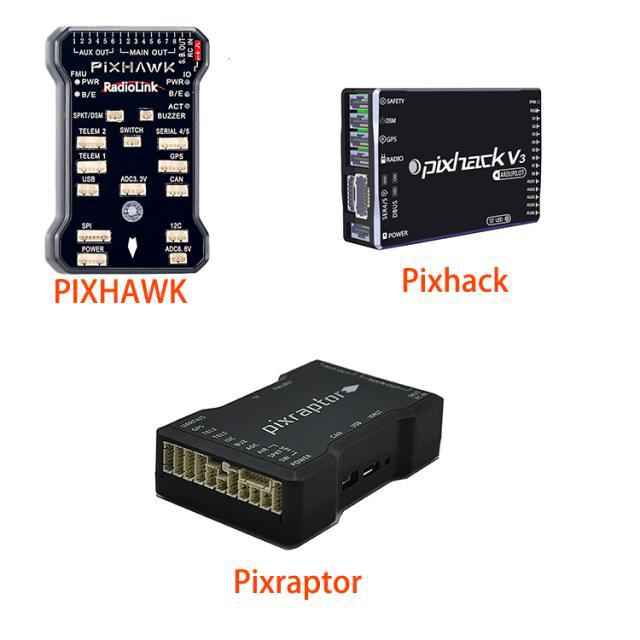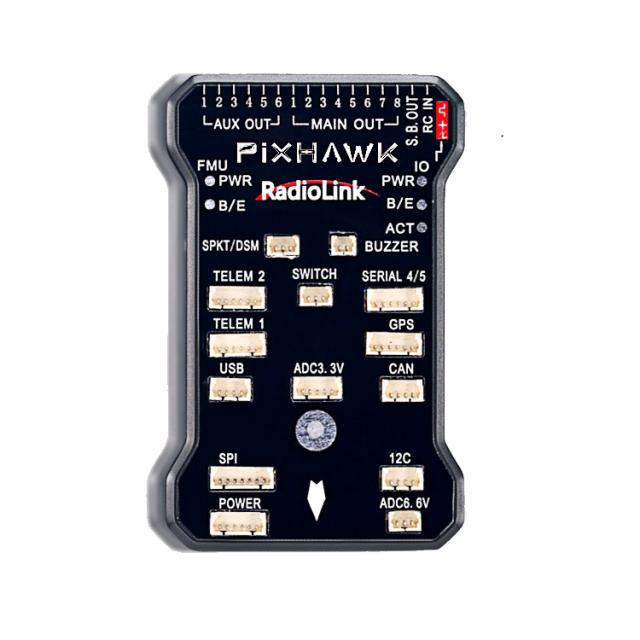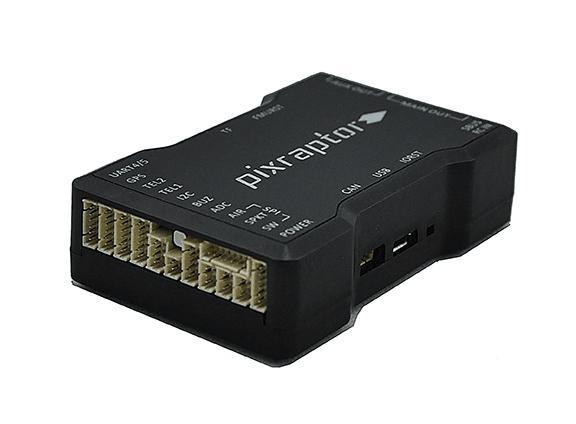Let's see what they look like first

PIXHAWK

Technical specifications
Processor: 32-bit STM32F427 ARM Cortex M4 core plus FPU (floating point arithmetic unit)
168 Mhz / 256 KB RAM / 2 MB Flash, 32-bit STM32F103 fail-safe coprocessor
Sensors: Invensense MPU6000 three-axis accelerometer / gyro, ST Micro L3GD20 16-bit gyroscope, ST Micro LSM303D 14-bit accelerometer / magnetometer, MS5611 MEAS barometer
Power supply: Good diode controller with automatic failover, 7V high voltage and high current output at the servo port, all peripheral equipment outputs have overcurrent protection, and all inputs have antistatic protection
Interface: 5 UART serial ports, one supports high power, two have hardware flow control
Spektrum DSM / DSM2 / DSM-X satellite input
Futaba SBUS input (output is being improved)
PPM sum signal
RSSI (PWM or voltage) input
I2C, SPI, 2 CAN, USB
3.3 and 6.6 ADC inputs
Dimensions: weight 38g, width 50 mm, height 15.5 mm, length 81.5 mm

Hardware parameters
Processor STM32F427
Coprocessor Failsafe co-processor STM32F100
Sensor
Accelerometer * 3 LS303D / MPU6000 / MPU6000
Gyro * 3 L3GD20 / MPU6000 / MPU6000
Compass Compass * 1 LS303D
Barometer * 2 MS5611
Interface
Mavlink UART serial port 2 (with hardware flow control)
GPS UART serial port 2
DEBUG UART serial port 1
Remote control signal input protocol PPM / SBUS / DSM / DSM2
RSSI input PWM or 3.3 analog voltage
I2C 2
CAN standard bus 1
ADC input 3.3V X1, 6.6V X1
PWM output Standard 8 PWM IO + 5 programmable IO
Supported models
Fixed Wing / 3-8 Rotor / Helicopter / VTOL VTOL / UAV / UAV
Working environment and physical parameters
PM working voltage 4.5 ~ 5.5 V
USB voltage 5.0 V +-0.25v
Servo voltage 4.8 ~ 5.4V
Working temperature -20 ~ 60 ° c
Size
Length X width X height 68 * 44 * 17
Weight 63g

Pixraptor is a modified flight controller based on 3DR's Pixhawk and added built-in vibration reduction. The hardware composition is the same as PIXHAWK and fully compatible with the original Pixhawk. In order to distinguish it from the original Pixhawk's naming, we have taken the hawk eagle in Pixhawk as the synonym Raptor and named it Pixraptor, hoping that it will soar in the air with more fierce performance! Pixraptor's improvements over Pixhawk are as follows: 1. Built-in IMU independent damping design. The first generation of Pixraptor uses a silicone platform. The second generation of Pixraptor refers to the design of Pixhawk V3. It is equipped with a foam damping system and uses an intermediate plate to support the IMU module. A barometer filter sponge is sandwiched between the pallet and the IMU module. In addition, according to feedback, the new version has also increased the pressure relief resistor of the IMU sensor power supply system with reference to the V3 circuit to ensure that the LSM303D repeatedly resets the power in time. 2.Integrate all Pixhawk DF13 device interfaces to the side, making the wiring more beautiful and convenient. All DF13 interface devices are compatible with the original Pixhawk devices, and the interface definitions are exactly the same. Only the external USB function interface of the DF13 is omitted. The function can be realized through a micro USB male and female extension cable. The original DF13 external USB interface is just a branch connected in parallel to the internal USB interface. 3. Put the LED indicator back. Because the original Pixhawk's LED status indicator is a top-lit display, when we are flying normally or when the flight control is installed in the mezzanine, we can't see the LED's lighting status at all, we must use an external LED module display. Therefore, we transferred the onboard LED module to the rear side, so that the status of the flight control LED can be seen without the external led module, and the LED settings on the rear side are more in line with the conventional habits of people taking off from the rear of the aircraft. Of course, you can still use the traditional external LED module to plug into the flight controller's I2C interface for external display. 4. In response to some problems exposed by Pixhawk in actual use, we have enhanced some component parameters, such as the problem that Pixhawk version 2.4.5 is easy to burn the receiver ’s Schottky tube. This Schottky is used for the common power supply of the IO system and the receiver. Diodes, although version 2.4.6 improves the design and uses two Schottky power supplies separately, but the maximum current of each Schottky design is still 500mA, there is still the risk of overcurrent damage.
From the data, the three airplane autopilot are just as powerful, but I personally think that Pixhackv3 is more powerful.
Contact: Fly Dragon Drone Tech.
Email: frank at dronefromchina.com
Add: NO. 9 Dayu Road PiDu distric, ChengDu 611730, China